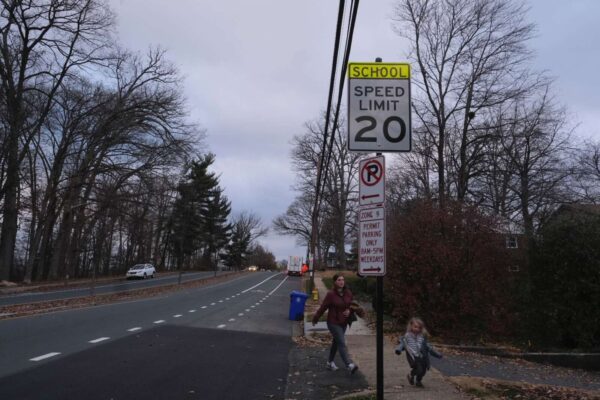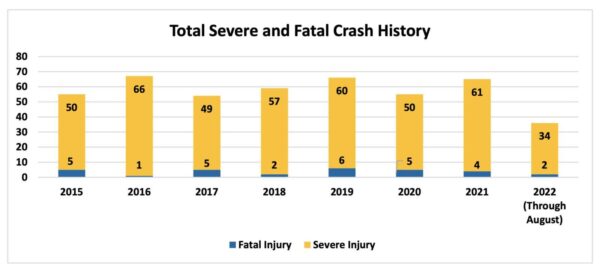
Arlington is proposing to lower speed limits near schools across the county to 20 mph as the county’s second year of Vision Zero enters the rear-view mirror.
This Saturday, the Arlington County Board is set to hear a proposal to expand these slow zones to all schools, after many people said they felt safer walking, biking and driving in 13 school zones where the speed limit has already dropped to 20 mph.
If the Board approves the changes, school zones will all get permanent signs with the new speed limits. The county says this is cheaper and more broadly applicable than flashing beacons, which will only be used on arterial streets within 600 feet of schools during arrival and dismissal times.
This change follows the approval earlier this year of moveable speed cameras to be installed in school and work zones, as well as calls from the Arlington County Board for a quicker staff response to critical crashes, after a driver fatally struck a pedestrian in an intersection near Nottingham Elementary School.
Schools have figured into other notable crashes, including a fatal crash involving a motorcyclist and a school bus in front of Drew Elementary in 2021 and a crash involving a drunk driver who killed a pedestrian near Thomas Jefferson Middle School this summer. In a less serious crash this fall, a driver struck an adolescent cyclist near Kenmore Middle School.
Lowering speeds is one action the county has taken over the last year and a half to work toward its goal of eliminating traffic-related fatalities and serious injuries by 2030, a plan known as Vision Zero.
“There are no corridors on county-owned roads that have a speed limit higher than 30 miles per hour, which is a big improvement. We’re very excited to say that,” Arlington Vision Zero coordinator Christine Sherman Baker said in a meeting last week.
In addition to lower speeds, the county has set up temporary school walking routes and roundabouts, completed 13 quick-build projects and made improvements to six critical crash sites and 14 crash “hot spots.” Staff are working on procuring speed cameras for school and work zones and red light cameras for six more intersections, which could be installed in 2023.
Amid the flurry of work, preliminary data from the first nine months of 2022 indicate crashes are down overall, according to a Vision Zero report released last month. As of Aug. 30, there were 1,313 crashes in Arlington, of which two were fatal and 34 were severe. (We’ve since reported on two additional fatal crashes.)

Pedestrian-involved crashes and crashes in intersections are both slightly lower, while bike crash figures are consistent with previous years. There has yet to be a crash in a work zone.
“Alcohol and speed prove to be some of our biggest challenges on our roadways,” Baker said in the meeting.
But some people say the county needs to be clearer in communicating if and how its work is reducing crashes as well as the dangers of driving.
“[The mid-year report] is a lot of, ‘Here are the things we did,’ and less ‘Here’s how close we are to Vision Zero’ or ‘Here’s how the things that we did actually reduced fatalities and serious injuries,'” said Pedestrian Advisory Committee representative Eric Goldstein during the Vision Zero meeting.
Representing the group Arlington Families for Safe Streets, cycling advocate Gillian Burgess said county leaders need to be clearer that “the most dangerous thing we do every day is get behind a wheel of a car.”
She said she was disappointed in the Arlington County Police Department’s messaging after a woman was fatally struck by an SUV driver in a crosswalk near Nottingham Elementary School.
“The message that came across… was that there was sun in the guy’s eyes, so it’s okay he killed someone,” she said. “The fact that the police department’s message, when this investigation was happening, was not that ‘Drivers need to be more careful, particularly when they cannot see,’ was really disappointing, and makes me less optimistic about the progress on Vision Zero.”
Earlier this fall the County Board called on staff to move faster in implementing safety changes along Little Falls Road, near the school and the scene of October’s fatal crash — along with prior deadly crashes. On Dec. 1 Arlington police issued 10 traffic citations in one hour along the stretch as part of targeted enforcement.
County staffers, meanwhile, are continuing to study whether it would make sense to make the intersection of Little Falls Road and John Marshall Drive, where the October crash took place, an all-way stop rather than a two-way stop.
Transportation Engineering and Operations Bureau Chief Hui Wang, however, says residents will likely see more instances where the county bypasses long data collection periods to improve its response to road safety concerns.
“We are trying to do more like this, but we also want to make sure we are not just getting ahead of ourselves,” she said. “There are things happening, always not fast enough for some folks, but we’re trying to catch up.”

